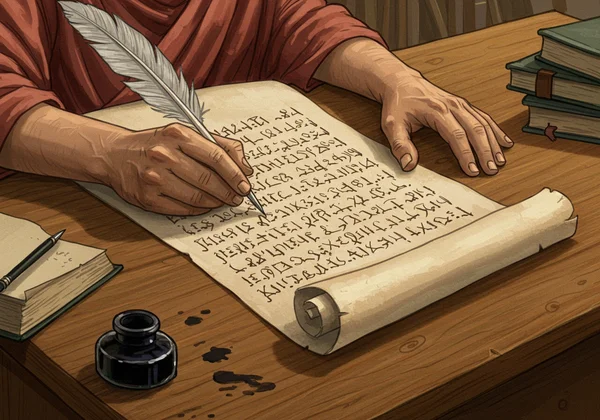History of Cursive: Why Learn Cursive Alphabet Today?
Once a cornerstone of education and communication, the art of writing the cursive alphabet has seen its prominence fade in a world dominated by keyboards and touchscreens. But like many timeless skills, it is experiencing a remarkable comeback. Have you ever wondered about the flowing script on historical documents or felt a desire to create a beautiful, handwritten note? This article delves into the fascinating history of cursive, explores the reasons for its decline, and answers the crucial question: why learn cursive in our modern, digital world? The journey to mastering this elegant art is more relevant and accessible than ever, and you can begin your journey today.
The Ancient Roots & Evolution of Cursive Handwriting
Cursive writing wasn't born overnight; it evolved over centuries out of a need for speed and efficiency. The term "cursive" originates from the Latin word currere, which means "to run," perfectly describing the flowing, connected nature of the script. Its origins trace back to ancient Rome, where scribes needed a faster way to write than using the disconnected Roman capital letters. This practical need gave birth to the first running scripts.
The evolution of the alphabet in cursive is a journey through history, reflecting changes in tools, culture, and educational philosophies. What began as a practical tool for merchants and scholars eventually became a symbol of education and personal refinement, a core component of the cursive writing alphabet taught in schools worldwide.

From Scribes to Schools: A Brief Cursive History Timeline
The journey of cursive from a specialist's tool to a classroom staple is a long one. Early forms were functional but lacked the uniform elegance we recognize today. During the Carolingian Renaissance in the 8th and 9th centuries, a more standardized and legible script, Carolingian Minuscule, emerged, laying the groundwork for modern lowercase letters. However, it was during the 18th and 19th centuries that cursive truly flourished with the development of specific teaching styles. Masters like Platt Rogers Spencer (Spencerian script) and Austin Norman Palmer (Palmer Method) created systems that emphasized rhythm and movement, making beautiful handwriting accessible to the masses. These methods became the standard for generations of students.
Different Styles of Cursive Throughout Eras
There isn't just one type of cursive; there are many beautiful styles of cursive. The elegant, ornate Copperplate style, with its sharp angles and varying pressure, was popular in the 18th century. It was followed by the more practical and rhythmic Spencerian script, which dominated American handwriting for decades. Later, the Palmer Method offered a simpler, more business-oriented approach that was easier to teach and learn. In the 20th century, styles like D'Nealian and Zaner-Bloser were developed specifically for elementary education, simplifying letterforms to make the transition from print to cursive smoother for young learners. Each style tells a story about its time and purpose, from formal correspondence to everyday classroom exercises.

The Decline of Cursive: Why Did it Fade from Schools?
In the late 20th and early 21st centuries, the flowing loops of cursive began to disappear from many school curricula. This shift was not sudden but a gradual response to changing educational priorities and technological advancements. Many educators and parents wondered if time spent on the a to z cursive alphabet could be better used elsewhere.
The debate over cursive's relevance became a focal point in education. As technology advanced, the arguments against dedicating significant classroom time to handwriting grew louder, leading to its decline in many school districts across the nation and the world.
Keyboarding vs. Cursive: The Rise of Digital Literacy
The most significant factor in cursive's decline was the digital revolution. As computers became classroom staples, keyboarding vs. cursive became a central debate. Proponents of digital literacy argued that typing was a more critical skill for future academic and professional success. With limited instructional hours, schools began prioritizing typing proficiency over handwriting, viewing it as the more practical and modern skill for communication in a digital age. The satisfying click-clack of keys began to replace the quiet scratch of pen on paper.

The Standardized Test Impact on Handwriting Instruction
Another powerful force was the increasing emphasis on standardized testing. With educational policies like No Child Left Behind, schools faced immense pressure to improve student performance on high-stakes tests, which were predominantly multiple-choice and computer-based. Cursive writing was not assessed on these exams, and as a result, the standardized test impact led many schools to cut it from their curriculum. The logic was simple: if it isn't tested, it isn't a priority. This shift directed valuable teaching time toward subjects and skills that directly influenced test scores, leaving little room for the art of handwriting.
The Resurgence: Why Learn Cursive in the Digital Age?
Despite its decline, cursive is making a powerful comeback. Educators, scientists, and parents are rediscovering that learning cursive is about more than just old-fashioned penmanship. The benefits extend far beyond aesthetics, impacting cognitive development, personal expression, and even digital creativity. People of all ages are finding compelling reasons to learn this skill, proving that its value enduring.
Today, mastering cursive is seen as a way to enhance learning and creativity. For anyone looking to start, high-quality resources like free cursive alphabet worksheets make it easy and enjoyable to begin.
Cognitive Benefits of Cursive Writing for All Ages
Research has illuminated the significant cognitive benefits of cursive writing. The connected, fluid motions of cursive activate different parts of the brain than printing or typing. This process helps develop fine motor skills, improves hand-eye coordination, and enhances neural connections. For students, learning cursive has been linked to better spelling, syntax, and composition skills because the connected letters help them see words as whole units. These benefits aren't limited to children; adults who learn or practice cursive can improve memory retention and stimulate their brains in unique ways.

Cursive for Personal Expression & Artistic Value
In an era of generic fonts and impersonal emails, handwriting offers a unique form of self-expression. Cursive for personal expression allows you to add a human touch to everything you write, from a heartfelt letter to a simple journal entry. Your handwriting is as unique as your voice or fingerprint. Developing an elegant cursive hand is not just a skill but an art form. It allows you to create beautiful wedding invitations, personalized greeting cards, or artistic journal pages, letting you discover your creativity in a tangible way.
Cursive's Modern Relevance & Future of Handwriting
The story of cursive is not one of replacement but of integration. The future of handwriting lies in its ability to coexist with and even complement our digital tools. It is no longer a question of pen versus pixel but how both can be used to enrich our lives. Cursive’s modern relevance is found in its ability to bridge the gap between the analog and digital worlds, offering unique benefits that typing alone cannot provide.
Integrating Cursive with Digital Tools like Font Generators
One of the most exciting developments is integrating cursive with digital tools. Today, you can learn the traditional art of cursive and then bring its elegance into your digital projects. For designers, content creators, and hobbyists, this opens up a world of possibilities. You can design a logo, create a social media graphic, or mock up an invitation using a beautiful cursive script. Tools like a Cursive Font Generator allow you to instantly transform typed text into an elegant script, proving that traditional skills have a firm place in modern design.

Preserving Handwriting Skills for Future Generations
Finally, learning cursive is about connection—to our history and to each other. By preserving handwriting skills, we ensure that future generations can read historical documents like the Declaration of Liberty in their original form. It keeps a tangible piece of our cultural heritage alive. Furthermore, it preserves a deeply personal form of communication. A handwritten note carries an emotional weight and intentionality that a text message simply cannot replicate, making it a skill worth cherishing and passing on.
Final Thoughts
Cursive is far more than an obsolete writing style; it is a skill with proven cognitive benefits, profound artistic value, and surprising modern relevance. From its practical origins to its current resurgence, the journey of the cursive alphabet reminds us that some skills are timeless. Whether you are a student, a parent, an educator, or a lifelong learner, rediscovering cursive can enrich your life in countless ways.
Ready to embark on this elegant journey? At Cursive Alphabet, we provide a complete, free, and interactive platform to help you learn, practice, and create. Explore our worksheets, test your knowledge, and master the art of cursive effortlessly.
Frequently Asked Questions About Cursive's History & Learning
How to quickly learn cursive and what's the first step?
The fastest way to learn is through consistent, focused practice. The first step is to master the basic strokes—the loops, curves, and connecting lines that form the foundation of all letters. Start by practicing individual lowercase letters, as they are used most frequently. Focus on one letter at a time until you are comfortable with its form and flow before moving on to the next.
What is the best way to start learning cursive as a beginner?
For a beginner, the best approach is to use structured resources. Start with printable worksheets that provide clear, guided examples of each letter. Our website offers a comprehensive cursive alphabet chart and individual letter practice sheets. Tracing the letters first helps build muscle memory, and then you can move on to writing them freehand. Practice in short, regular sessions to avoid fatigue and build confidence.
Is learning cursive still important in today's digital world?
Absolutely. As discussed, learning cursive offers significant cognitive benefits, improves fine motor skills, and enhances memory retention. It also provides a unique and personal form of expression that is valuable in both personal and professional contexts. It complements digital skills rather than competing with them, making you a more versatile communicator.
Where can I find free resources to practice cursive alphabet letters?
There are excellent free resources available online. Our platform is a one-stop resource offering everything you need to start. You can find a complete set of free cursive resources, including downloadable cursive alphabet printable worksheets for every letter, interactive learning modules to guide your practice, and even a font generator to see any text in beautiful cursive.